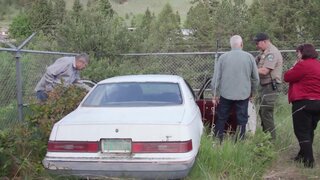Create a free profile to get unlimited access to exclusive videos, breaking news, sweepstakes, and more!
‘I Can’t Believe I Did It’: ‘Cold Justice’ Digs Into Native American Mother’s 1986 Murder
Who killed Shannon Poteet, a young Native American mom, in 1986? The "Cold Justice" team heads to Wisconsin an attempt to find answers.
In the fall of 1986, Shannon Poteet, 21, a warm and outgoing Native American woman in Ferry County, Washington, was ready for a fresh start. She was in the process of divorcing her then 24-year-old husband, Lonnie Poteet, and was working for the U.S. Forest Service and tending to her 11-month-old daughter, Sara.
But in November 1986, Shannon vanished. According to Lonnie, she left Sara with him on November 8 and never returned. Three days later, her car was found in town with blood in the trunk. The driver’s seat was, oddly, pushed back as far as it could go — Shannon was just 5'1."
The investigation into Shannon’s disappearance went cold for eight years. Then, on September 30, 1994, Shannon’s remains, identified through dental records, were found by a hiker who was walking through a forest outside.
On an episode of “Cold Justice,” airing Saturdays at 8/7c on Oxygen, veteran prosecutor Kelly Siegler and Cpt. Terri Hook, of the Oneida County Sheriff’s Office in Wisconsin, travel to Ferry to help work the case.
They work alongside Fmr. Det. Mike George of the Ferry County Sheriff’s Office, Fmr. Lt. Vern King of the Los Angeles Police Department, and Ferry County Sheriff Ray Maycumber, who searched for Shannon when she went missing.
Although investigators couldn’t determine Shannon’s cause of death, her manner of death was determined to be a homicide. As in many cases in which a spouse goes missing, her husband was considered as a person of interest.
The investigation begins by reviewing possible suspects, including Lonnie. They question how he felt about the couple’s separation to determine if that could be related in some way to a motive.
Through civilian witnesses, they learn that Lonnie was unemployed and had a very short fuse. He allegedly flew into a rage at the drop of a hat and could turn physically violent. He even allegedly head-butted Shannon on one occasion. “He was just a brute,” one person stated.
They also find out that Shannon’s daughter, Sara, now an adult, had been told by Lonnie that her mother, who was devoted to her daughter, had just up and left her. “It was pretty gut-wrenching,” says Sara.
The team also considers Lonnie’s longtime close friend, Clay Kjos, who falls under suspicion for a number of reasons. “He admitted seeing Lonnie on that Friday night that it's believed that Shannon was murdered,” says Siegler. Moreover, one witness reported seeing what appeared to be blood on Clay’s pants and shoes that same night.
In a lucky turn of events, Shannon's abandoned vehicle was recovered. It was taken to the sheriff’s department for processing and has been there ever since. Evidence from the trunk is sent for DNA analysis.
Although investigators don’t have a sample of Shannon’s DNA, they do have Sara’s and do a maternity calculation. The results find the probability that the blood from the carpet in the car’s trunk came from Sara’s mother is greater than 99.9 percent.
“The blood in the trunk of that car is Shannon’s,” says Siegler. “That is undeniable physical evidence that we can now use to lock down our theory of what happened to Shannon.”
Analysis of Kjos’s shoes reveal that the substance on them wasn’t blood. After questioning Kjos, the team concludes that he is cooperative and consistent and “does not sound like he’s trying to hide anything.”
The focus turns squarely to Lonnie Poteet and the team digs deeper into the couple’s estranged marriage by getting statements from various witnesses.
A friend says that Lonnie and Shannon were complete opposites in every way and that it appeared that he regarded her as one of his “possessions.”
Shannon’s lawyer states that she was “adamant that she didn’t want to be with him anymore” — and she didn’t want Sara with him. Shannon was afraid of Lonnie, according to the attorney.
From the pastor the Poteets saw for marriage counseling just before Shannon vanished, investigators learn that Lonnie had said that his wife had gone out of town with a boyfriend and left the baby behind. That was inconsistent with what Lonnie had originally told investigators.
With all that in mind, the investigators seek to determine if Lonnie made any admissions after all these years by talking to witnesses closest to him.
Ed Bacon, who Lonnie went to school with and played football with, claims that he saw Lonnie driving Shannon’s car the same night she is believed to have been murdered.
Jeff Owens, Lonnie’s brother, says that his sibling had a lot of anger issues. Owens also claims that during a night of drinking, Lonnie said, “I can’t believe I did it.” Owens alleged he inquired if Lonnie had something to do with Shannon’s disappearance, and Lonnie warned him to never ask that again. “He didn’t say he killed her,” says Owens. “But in my mind that was as close to a confession I’m going to get from him.”
When investigators drive to Montana to speak with Lonnie Poteet, he denies any culpability before shutting the meeting down. He says further communication will be through his lawyer.
After crossing Kjos off the suspect list, the investigators present their case to the Ferry County District Attorney.
Following the meeting, Siegler reports to Sara and her aunts that the DA is very positive about it. “She likes what she hears,” says Siegler.
To learn more about this case, watch “Cold Justice,” airing Saturdays at 8/7c on Oxygen. You’ll find more episodes here


































